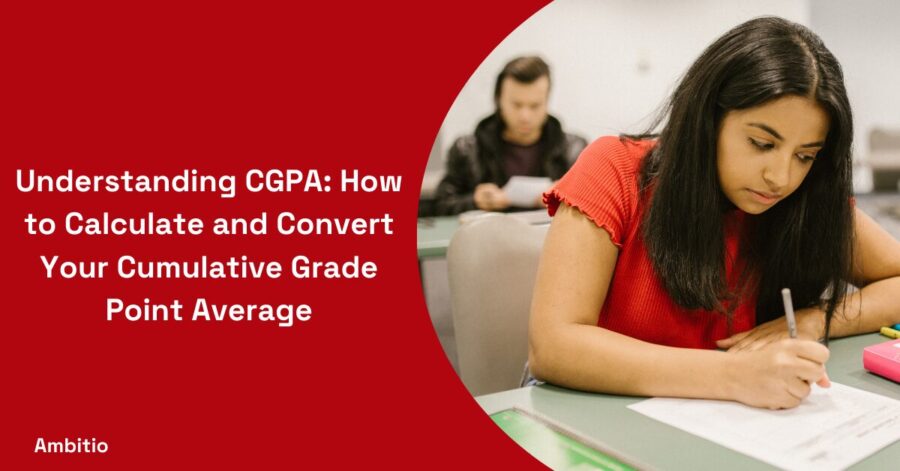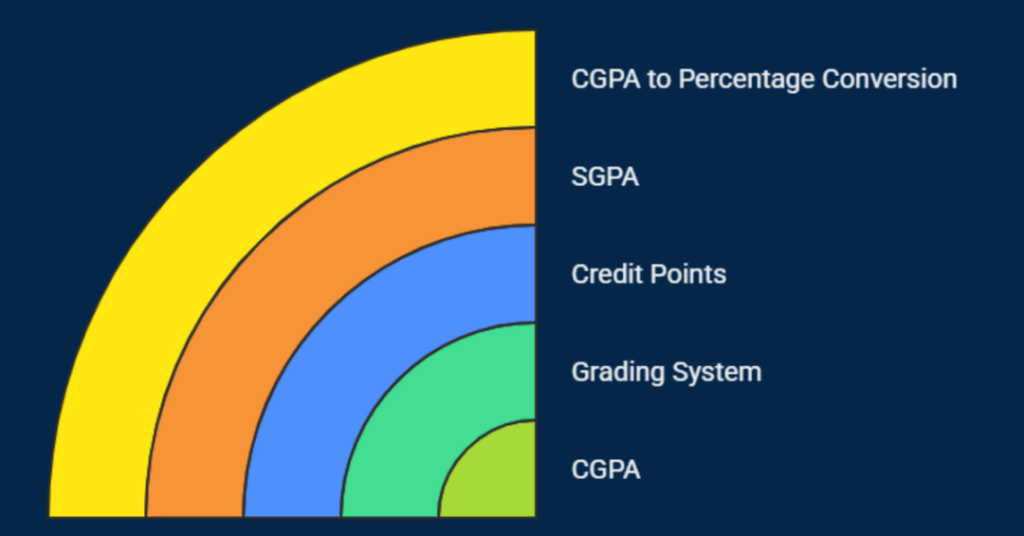27 July 2025
5 minutes read
Everything You Know About CGPA 2025: A Complete Guide

Key Takeaways
- CGPA affects more than just marks—it shapes your academic and career opportunities globally.
- Multiply your CGPA by 9.5 under the 10-point scale to get the correct percentage.
- Always calculate CGPA using weighted grade points based on credit hours for accuracy.
An 8.2 CGPA doesn’t mean you’re an 82% student—nope, it’s not that simple. You don’t just “multiply your CGPA by 10” and call it a day. The actual CGPA to percentage formula says multiply by 9.5. Why? Because most Indian universities follow a 10-point grading system where 9.5 is the standard multiplier. And yes, that tiny decimal makes a big difference when applying for jobs or higher studies.
But most students don’t even know what CGPA stands for (it’s Cumulative Grade Point Average, by the way). They blindly Google “CGPA calculator” or “convert CGPA to percentage” without understanding what the grade points, credit points, or weighted average actually mean. That’s the problem. Everyone wants the shortcut, but no one explains the logic. This guide fixes that. No fluff, no jargon—just clear, actionable knowledge that helps you use your CGPA smartly. Let’s get it right.
What Is CGPA?
If you think CGPA is just a fancier way of saying marks, think again. It’s that silent academic number that looks harmless on your report card but can either open doors or slam them shut when applying to top educational institutions. And no—you don’t convert CGPA to percentage by just multiplying it with 10. That myth needs to die.

The truth? You multiply your CGPA by 9.5—because that’s how the grading system under India’s 10-point scale works. And if that made your brain itch, good. You’ve just scratched the surface of how much you don’t know about CGPA. Let’s fix that.
- CGPA stands for Cumulative Grade Point Average, and it reflects your overall academic performance across semesters—not just one exam or subject.
- Your CGPA is not just about grade points earned; it’s a weighted average based on the credit points assigned to each subject by most educational institutions.
- To convert CGPA into a percentage, don’t guess—use the actual cgpa to percentage formula, which says multiply your CGPA by 9.5 under the standard grading scale.
- SGPA or Semester Grade Point Average is calculated individually for each term, and your CGPA is the overall average—it’s important to divide the total grade points by the number of credit hours.
- A proper CGPA to percentage calculator or CGPA calculator is not optional—it helps you understand how each point affects your academic performance, and where you need to improve your CGPA strategically.
How To Convert CGPA To Percentage?
This isn’t school math where you round off and move on. This is CGPA to percentage conversion, where one small misstep could mess with your overall percentage, your resume, or even your college admission abroad. It’s not rocket science, but it does involve more than just a CGPA converter or a random online calculation. You’ve got to use the CGPA the way it’s meant to be used—like someone who knows what they’re doing. Let’s show you how.
Step 1: Understand the CGPA Scale Used
Different universities follow different systems. Most Indian institutions follow the 0 to 10 CGPA scale, while others may use a 4-point system. Knowing the scale used is non-negotiable before beginning any CGPA conversion.
Step 2: Use the Standard CGPA to Percentage Formula
To convert CGPA into percentage under the Indian 10-point system, the standard method is:
Percentage = CGPA × 9.5.
Yes, that’s it. Don’t improvise, don’t guess, multiply the grade points by 9.5. That’s your actual CGPA in percentage.
Step 3: Consider Weighted Grade Points
If you’re aiming for accuracy, you need to factor in weighted grade points based on credit hours. Just averaging your subjects isn’t enough—you need to account for the average grade point per credit. This is how you truly calculate CGPA before conversion.
Step 4: Don’t Trust Just Any Converter
Online converters are tempting, but most ignore key factors like subject weightage. Always cross-check using your own CGPA scores and credit data. This manual calculation may take 5 minutes—but it’s the smarter choice.
Step 5: Use CGPA Smartly on Applications
Once you’ve got your CGPA in percentage, don’t just copy-paste it everywhere. Different institutions interpret CGPA scores differently. Some want raw CGPA, others demand CGPA into percentage, and a few ask for both. So, use CGPA smartly based on the requirement.
What Is The Difference Between CGPA System And GPA?
GPA and CGPA like they’re the same dish on different plates—stop. That’s like mistaking a Rupee for a Dollar because they both have numbers on them. The truth? CGPA and GPA are miles apart in meaning, usage, and math. And when you’re filling out international applications, attaching transcripts, or using a CGPA to percentage converter to show your marks, the difference isn’t just technical—it’s tactical. If you’re serious about decoding the student’s academic performance on a global scale, read this like your future depends on it. Because it just might.
Now let’s slice through the confusion with a clear, fact-packed comparison.
| CGPA System | GPA System |
|---|---|
| CGPA stands for Cumulative Grade Point Average—a metric used by Indian universities, calculated on a 10-point CGPA scale. | GPA, often found in the U.S., is calculated on a 4.0 scale and usually reflects semester-wise performance. |
| The CGPA is calculated using a simple formula: the average of the grade points earned, adjusted by the total number of credit hours. | GPA usually does not consider weighted subjects unless explicitly calculated as cumulative GPA—a key distinction between CGPA and GPA. |
| To convert CGPA into a percentage, you multiply the grade points by 9.5—a standard CGPA conversion formula that gives you the accurate percentage equivalent. | There is no fixed formula to convert GPA into percentage—it depends on the grading scale used by the institution. |
| A 10-point grading scale offers more range and flexibility in grading. A high CGPA like 8.2 is strong—but its percentage using CGPA (77.9%) must be shown properly using a CGPA to percentage conversion table. | The 4-point CGPA system is compressed. A 3.2 GPA might sound average but could mean something entirely different depending on the percentage to CGPA conversion used. |
Conclusion
Don’t rely on random calculators or one-size-fits-all formulas. Know what CGPA stands for, how it’s calculated, and when to use it. Because the smarter you are with your numbers, the better you stand out—on paper and in real life. CGPA isn’t just a number sitting on your marksheet. It’s a system. A weighted one. A misunderstood one. And definitely not something you should eyeball or estimate with guesswork.
CGPA is just one part of the equation—your entire profile tells the real story. At Ambitio, our AI-powered study abroad experts help you build a standout application that goes beyond grades. No generic templates, no guesswork—just a strategy that proves you’re the right fit.
FAQs
Q1: What is the full form of CGPA?
The full form of CGPA is Cumulative Grade Point Average.
Q2: How do I calculate my CGPA?
Add the grade points of all subjects, then divide by the total number of subjects.
Q3: How can I convert my CGPA to a percentage?
Multiply your CGPA by 9.5 to get the equivalent percentage.
Q4: Is the CGPA to percentage conversion accurate?
It gives a general idea, but accuracy varies based on the institution’s grading system.
Q5: Can I convert my percentage to CGPA?
Yes, divide your percentage by 9.5 to get your CGPA.

You can study at top universities worldwide!
Get expert tips and tricks to get into top universities with a free expert session.
Book Your Free 30-Minute Session Now! Book a call now




























